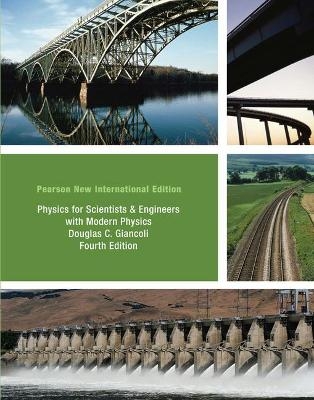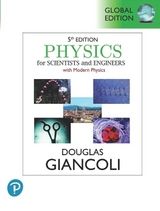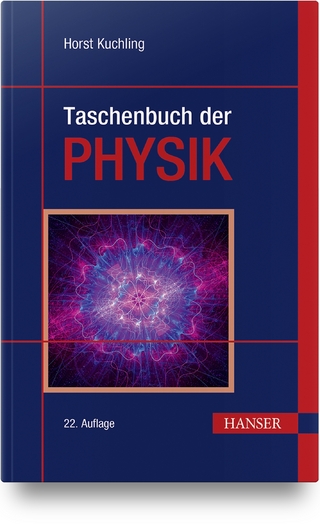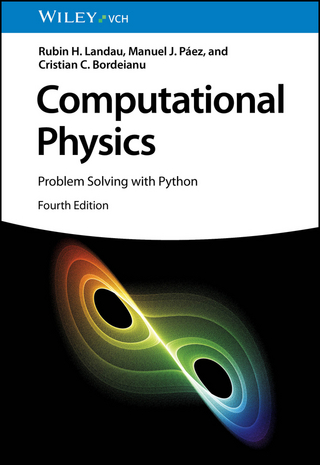
Physics for Scientists & Engineers with Modern Physics
Pearson Education Limited (Verlag)
978-1-292-02076-1 (ISBN)
- Titel erscheint in neuer Auflage
- Artikel merken
This long-awaited and extensive revision maintains Giancoli's reputation for creating carefully crafted, highly accurate and precise physics texts. Physics for Scientists and Engineers combines outstanding pedagogy with a clear and direct narrative and applications that draw the student into the physics. The new edition also features an unrivaled suite of media and on-line resources that enhance the understanding of physics.
This book is written for students. It aims to explain physics in a readable and interesting manner that is accessible and clear, and to teach students by anticipating their needs and difficulties without oversimplifying.
Physics is a description of reality, and thus each topic begins with concrete observations and experiences that students can directly relate to. We then move on to the generalizations and more formal treatment of the topic. Not only does this make the material more interesting and easier to understand, but it is closer to the way physics is actually practiced.
CONTENTS OF VOLUME 1
APPLICATIONS LIST xii
PREFACE xiv
AVAILABLE SUPPLEMENTS AND MEDIA xxii
NOTES TO STUDENTS (AND INSTRUCTORS) ON THE FORMAT xxiv
COLOR USE: VECTORS, FIELDS, AND SYMBOLS xxv
CHAPTER1: INTRODUCTION, MEASUREMENT, ESTIMATING
1—1 The Nature of Science
1—2 Models, Theories, and Laws
1—3 Measurement and Uncertainty; Significant Figures
1—4 Units, Standards, and the SI System
1—5 Converting Units
1—6 Order of Magnitude: Rapid Estimating
*1—7 Dimensions and Dimensional Analysis
SUMMARY
QUESTIONS
PROBLEMS
GENERAL PROBLEMS
CHAPTER 2: DESCRIBING MOTION: KINEMATICS IN ONE DIMENSION
2—1 Reference Frames and Displacement
2—2 Average Velocity
2—3 Instantaneous Velocity
2—4 Acceleration
2—5 Motion at Constant Acceleration
2—6 Solving Problems
2—7 Freely Falling Objects
*2—8 Variable Acceleration; Integral Calculus
*2—9 Graphical Analysis and Numerical Integration
SUMMARY
QUESTIONS
PROBLEMS
GENERAL PROBLEMS
CHAPTER 3: KINEMATICS IN TWO OR THREE DIMENSIONS; VECTORS
3—1 Vectors and Scalars
3—2 Addition of Vectors–Graphical Methods
3—3 Subtraction of Vectors, and Multiplication of a Vector by a Scalar
3—4 Adding Vectors by Components
3—5 Unit Vectors
3—6 Vector Kinematics
3—7 Projectile Motion
3—8 Solving Problems Involving Projectile Motion
3—9 Relative Velocity
SUMMARY
QUESTIONS
PROBLEMS
GENERAL PROBLEMS
CHAPTER 4: DYNAMICS: NEWTON’S LAWS OF MOTION
4—1 Force
4—2 Newton’s First Law of Motion
4—3 Mass
4—4 Newton’s Second Law of Motion
4—5 Newton’s Third Law of Motion
4—6 Weight–the Force of Gravity; and the Normal Force
4—7 Solving Problems with Newton’s Laws: Free-Body Diagrams
4—8 Problem Solving–A General Approach
SUMMARY
QUESTIONS
PROBLEMS
GENERAL PROBLEMS
CHAPTER 5: USING NEWTON’S LAWS: FRICTION, CIRCULAR MOTION, DRAG FORCES
5—1 Applications of Newton’s Laws Involving Friction
5—2 Uniform Circular Motion–Kinematics
5—3 Dynamics of Uniform Circular Motion
5—4 Highway Curves: Banked and Unbanked
*5—5 Nonuniform Circular Motion
*5—6 Velocity-Dependent Forces: Drag and Terminal Velocity
SUMMARY
QUESTIONS
PROBLEMS
GENERAL PROBLEMS
CHAPTER 6: GRAVITATION AND NEWTON’S6 SYNTHESIS
6—1 Newton’s Law of Universal Gravitation
6—2 Vector Form of Newton’s Law of Universal Gravitation
6—3 Gravity Near the Earth’s Surface; Geophysical Applications
6—4 Satellites and “Weightlessness”
6—5 Kepler’s Laws and Newton’s Synthesis
*6—6 Gravitational Field
6—7 Types of Forces in Nature
*6—8 Principle of Equivalence; Curvature of Space; Black Holes
SUMMARY
QUESTIONS
PROBLEMS
GENERAL PROBLEMS
CHAPTER 7: WORK AND ENERGY
7—1 Work Done by a Constant Force
7—2 Scalar Product of Two Vectors
7—3 Work Done by a Varying Force
7—4 Kinetic Energy and the Work-Energy Principle
SUMMARY
QUESTIONS
PROBLEMS
GENERAL PROBLEMS
CHAPTER 8: CONSERVATION OF ENERGY
8—1 Conservative and Nonconservative Forces
8—2 Potential E
| Erscheint lt. Verlag | 5.8.2013 |
|---|---|
| Verlagsort | Harlow |
| Sprache | englisch |
| Maße | 230 x 275 mm |
| Gewicht | 3180 g |
| Themenwelt | Naturwissenschaften ► Physik / Astronomie |
| ISBN-10 | 1-292-02076-8 / 1292020768 |
| ISBN-13 | 978-1-292-02076-1 / 9781292020761 |
| Zustand | Neuware |
| Informationen gemäß Produktsicherheitsverordnung (GPSR) | |
| Haben Sie eine Frage zum Produkt? |
aus dem Bereich



